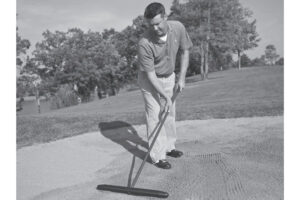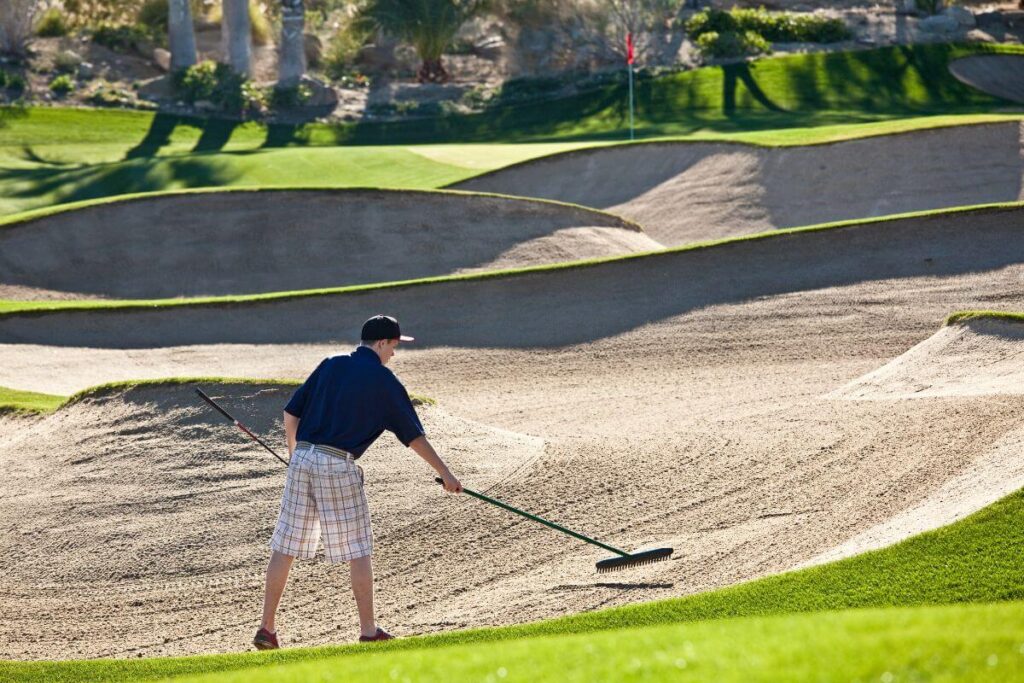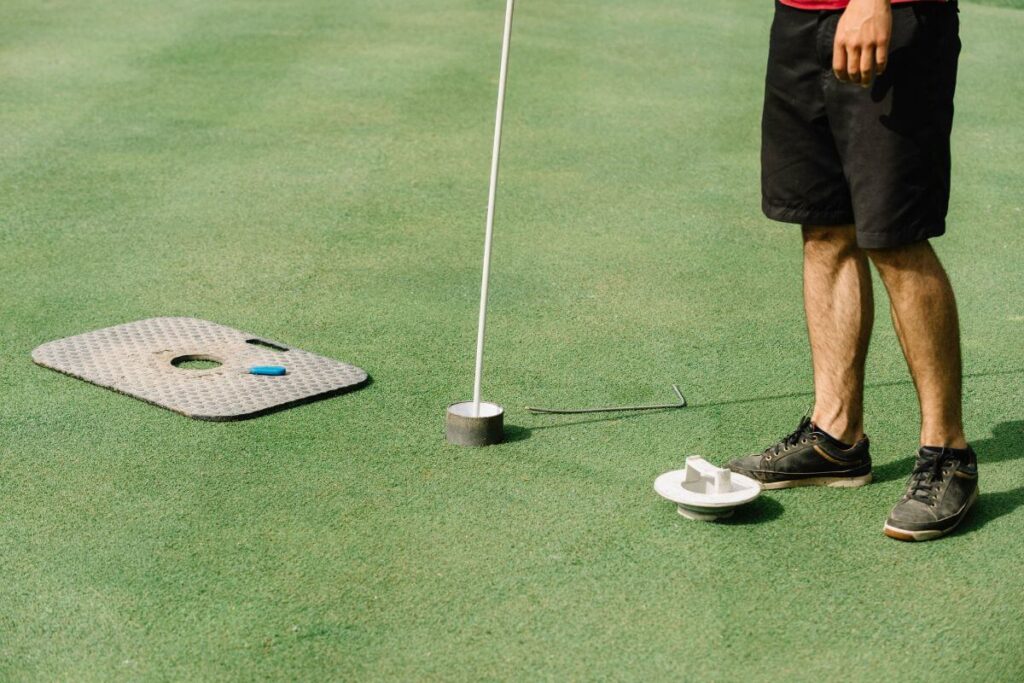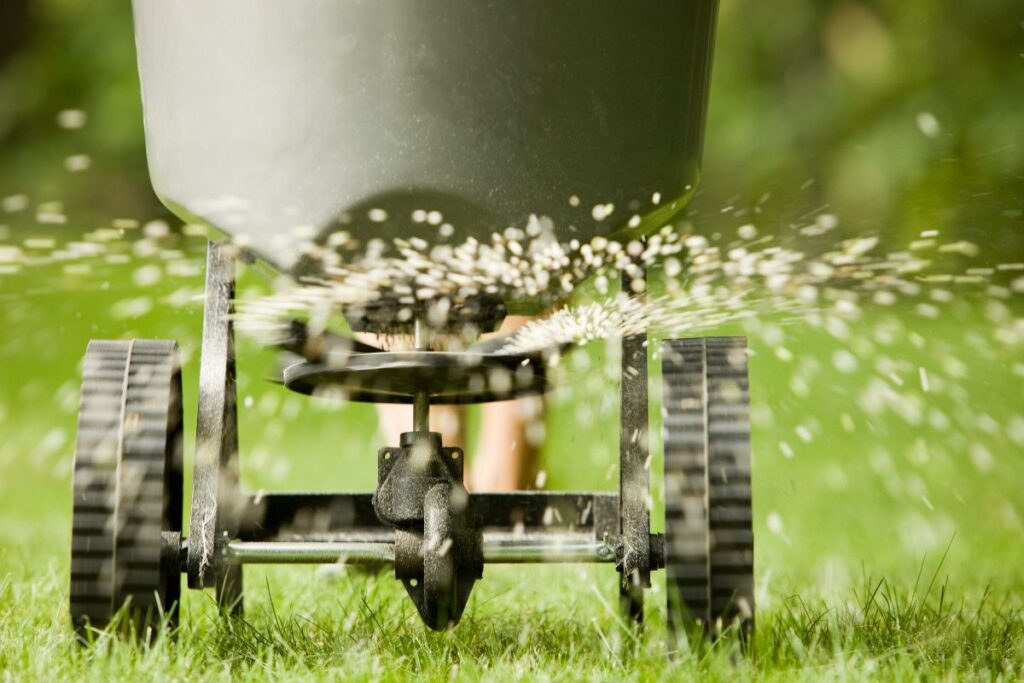The daily routine of golf course maintenance includes raking the bunkers. Prior to the invention of the mechanical bunker rake, caring for bunkers on an 18-hole course could be a monotonous chore taking the efforts of several workers the better part of a day.
A superintendent from Georgia was the first to invent a motorized bunker rake. Never mind that the contraption looked like a moon buggy. It was a prototype and soon copied by all the major golf course equipment manufacturers.
Raking bunkers was changed forever. Bunker designs were no longer restricted and architects immediately set out to create large and impressive fields of sand that accentuated the playing areas and made for target golf at its best.
Table of Contents
Steps To Rake A Bunker
Here are the steps to raking a bunker properly:
- Place the hand rakes outside the bunker, while inspecting and removing debris.
- If using a mechanical bunker rake, operate at half throttle through the center, making a gentle turn at the end, and continue with the same process.
- Stay away from the bunker’s edge by at least a foot. Touching the grass or the soil with the rake will contaminate the sand.
- When the entire bunker has been raked, exit carefully, making sure not to drag any sand onto the surrounds.
- Hand-rake the edges upward, and make sure that any marks left at the exit are obliterated. Any ruts in the bunker should be removed by hand-raking.
- Replace the hand rakes inside the bunkers (or the area that is designated for rakes), and also check for damaged handles and tines.
Who Is Required To Rake Bunkers?
The job of raking bunkers is usually reserved for members of the greens staff that have been trained to operate the mechanical bunker rake with expertise.
Raking bunkers is just as important as other assignments and must be done with the same degree of perfection that is applied to all other tasks.
To rake bunkers competently and efficiently requires an energetic person who can get on and off the machine in a jiffy. The person in charge of raking should be ahead of the golfers and alert to their whereabouts.
If raking the bunker while golfers are approaching, they must be able to get out of their way quickly and stay out of the way of the players.
What Type Of Rake Is Used For Bunker?
On older golf courses with traditional bunkers, there may not be enough space for the bunker machines to maneuver and, in such cases, hand-raking is the only alternative.
The bunkers at Oakmont of USGA fame in Pittsburgh were hand-raked with hay rakes for many years. These antique instruments left characteristically deep grooves that many golfers despised and others thought lent charm to this famous course.
Golfers are usually so absorbed in their game that they either forget to rake the sand or do a haphazard job. At the same time, golfers should be encouraged to rake bunkers with two hands on the rake so as to achieve a more acceptable result.
If the bunkers have been machine-raked in the morning, superintendents who know the shortcomings of their players should consider sending out staff in the afternoon to touch up the bunkers by hand-raking. The selection of rakes to maintain the bunker is important.
Old fashioned hay rakes were often chosen that had wooden, evenly spaced teeth; its large width enabled the individual who was raking to complete the work fast and efficiently.
These old-fashioned wooden rakes have been phased out and are usually replaced with fiberglass rakes that are available in a variety of sizes.
Many superintendents have found that the longhandled, large-headed fiberglass rakes, which are easier to reach into the bunker, are preferred by the golfers.
Hand-raking the sand in bunkers produces superior results

Some golf clubs provide small bunker repair rakes which are often thrown about with no regard for the players that follow.
Where To Place The Rake?
Where to place the rake is often discussed. Some say outside the bunker and others say inside. Logically speaking, it would be better to place the rake inside and away from the line of play, to prevent golf balls from being deflected.
Some courses provide rakes on the golf cart, thus keeping the rakes from being placed in or around the bunker.
Edging The Bunkers
On finely manicured golf courses, the bunkers are characterized by a sharp, distinctive edge. This is the result of meticulous work by proficient greenkeepers.
If left unattended, the grass surrounding the bunkers would quickly grow into the sand, causing the bunker to lose its shape and definition.
Golfers would have difficulty determining whether their balls were inside or outside the bunker, and because different rules apply, there could be problems with interpretations and with fellow players.
For the longest time, superintendents had their staff hand-edge bunkers several times during the golfing season. Power edgers with oscillating blades then came into use, and more recently used are the power trimmers with reciprocating teeth.
Edging the bunker with a mechanical trimmer.

A sharply defined edge is created with little effort, and now the work can be completed quickly. The location of the bunker line cannot always be determined with certainty.
Maintaining The Outline Of The Bunker
Unless edging is done routinely, it is possible for the bunker’s outline to be lost. If not maintained regularly, bunkers can quickly lose their original shape.
In this situation, before any serious edging is contemplated, the superintendent should outline the bunker with a paint gun.
After the bunker has been edged, the pieces of sod and strings of rhizomes must be removed from the bunker. The sand on the greenside should be raked back up leaving a lip at the grass level. On the backside of the bunker, the sand should be raked forming a soft rounded edge that will encourage playable lies.
When edging fairway bunkers, a lip is not necessary and the sand should be raked to the grass level.
An inexpensive quick fix for edging bunkers on golf courses that have limited staff or the proper machinery can try to address the edging situation by different means.
Though it will not have the same appearance, it may be more cost effective and less time consuming.
We are referring to a process that involves spraying the edge of a bunker with glyphosate or commonly known as Roundup®, a grass killer that effectively stops the grass from growing into the sand.
There is another important benefit; by eliminating the use of the mechanical edger, we are also eliminating the chance that the surrounding soil will mix accidentally with the bunker sand. Roundup® must be applied carefully in a narrow band; otherwise, it will look unsightly.



